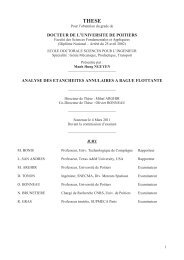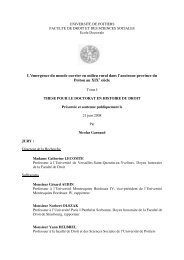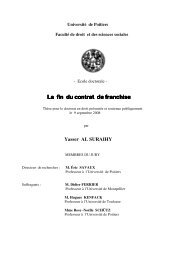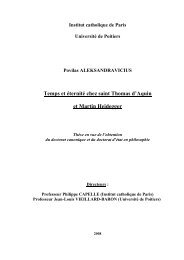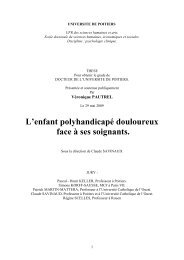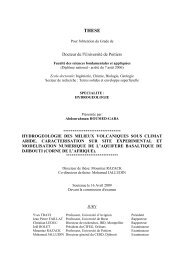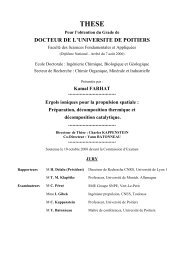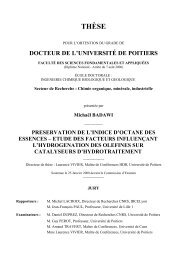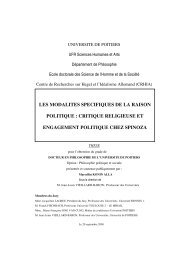Etude et développement d'un actionneur plasma à décharge à ...
Etude et développement d'un actionneur plasma à décharge à ...
Etude et développement d'un actionneur plasma à décharge à ...
You also want an ePaper? Increase the reach of your titles
YUMPU automatically turns print PDFs into web optimized ePapers that Google loves.
Annexes<br />
actuator is usually made of two thin electrodes asymm<strong>et</strong>rically flush mounted on a dielectric wall. When a highvoltage<br />
is supplied to one of the electrode (the second being grounded), a <strong>plasma</strong> discharge is produced on the<br />
dielectric surface. The <strong>plasma</strong> extension depends on the characteristic of the input electric signal [15]. In 1998,<br />
Roth has demonstrated that a local flow can be produced in the <strong>plasma</strong> region, tangentially to the dielectric wall<br />
surface [16]. Different authors have investigated the mechanism of the local airflow formation and it appears that<br />
charged particles (ions and electrons) are produced in the inter electrode space and that the momentum transfer<br />
from the charged particles to the neutral atmospheric air components produces a local flow of a few m.s -1 ,<br />
usually called ‘ionic wind’ or ‘electric wind’ [17-21]. Further investigations have been performed in order to<br />
optimize the electrode geom<strong>et</strong>ry, resulting in the improvement of the ‘electric wind’ produced by a single DBD<br />
actuator and a local flow of approximately 7 m/s can be created [22-23]. Preliminary studies have demonstrated<br />
the capability of a DBD actuator to be operated at low pressure or high humidity conditions corresponding to<br />
real atmospheric flight conditions [24-26]. Each new publication related to DBD actuator tends to demonstrate<br />
that this device can comp<strong>et</strong>e with others active control devices, such as blowing j<strong>et</strong>s, synth<strong>et</strong>ic j<strong>et</strong>s or<br />
piezoelectric devices.<br />
Dielectric barrier discharge <strong>plasma</strong> actuators are used to impart momentum into moderate Reynolds number<br />
flows and the achieved flow control take advantages of the wide operating frequency range of DBD devices.<br />
Indeed, a previous study has reported that the produced airflow can impart momentum at the electric input<br />
frequency [23, 27]. This property has been extensively used to promote partial or full airflow reattachment along<br />
airfoils resulting in significant lift increase. For instance, Corke <strong>et</strong> al. [7] have demonstrated that a single DBD<br />
operating at a reduced frequency equal to unity induces an improvement of NACA 0015 performances compared<br />
to other reduced frequency values. The effects of the reduced frequency on the improvement of airfoils<br />
performance were previously reported and summarized by other authors [28-29], but Corke <strong>et</strong> al. [7, 12] also<br />
demonstrate by force balance measurements that a low duty-cycle value (typically lower than 10%) is sufficient<br />
to initiate and sustain an enhancement of the lift. The significant effects of low duty-cycle values were recently<br />
confirmed by Goksel <strong>et</strong> al. [10] or Greenblatt <strong>et</strong> al. [30], for instance. The improvement of the effectiveness of<br />
the actuator when operating at reduced frequency equal to unity and low-duty-cycles is supposed to derive from<br />
the excitation of the natural instabilities of the free shear layer located above the airfoil in post-stall regimes.<br />
Although several studies demonstrated that flow reattachment can be forced by imparting low momentum close<br />
to the separation point, the mechanisms responsible for the reattachment are still unclear. The manipulation of<br />
the shedding of coherent structures occurring at the leading edge is often mentioned as the primary flow control<br />
process. However, the interactions b<strong>et</strong>ween the ionized airflow produced by the single DBD actuator and the<br />
overall flow structures remains to be experimentally investigated and characterized.<br />
In the present study the flow over a NACA 0015 in post-stall regime (α=16 degrees) is experimentally<br />
investigated. A single DBD actuator is mounted at the leading edge of the airfoil and the profile is placed in an<br />
open wind tunnel producing a free-stream velocity of 20 m/s. A time-resolved particle image velocim<strong>et</strong>ry<br />
(TRPIV, 10 kHz) system is used to observe and measure the baseline flow and also the forced flow reattachment<br />
by steady actuation. The consequences of the airflow controlled by a non-thermal actuator are also introduced for<br />
unsteady actuations performed at different reduced frequencies and duty-cycle values. The analysis proposed in<br />
the present paper concerns the time-averaged velocity fields and non-stationary data such as the temporal<br />
evolution along extraction lines, the instantaneous vorticity and cross correlation function dedicated to the<br />
characterization of the natural or controlled vortex shedding. The last part of this study deals with the<br />
reattachment process observed for steady and unsteady actuations. It is expected that the results of this study will<br />
give a b<strong>et</strong>ter insight in the control processes following the actuation produced by a single DBD actuator.<br />
2. Experimental S<strong>et</strong>up<br />
The NACA 0015 model has a chord length of 200 mm and a spanwise length of 296 mm. The model is<br />
realized in two separated parts. The first, made of polyur<strong>et</strong>hane, is the scaffold of the model (see figure 1). The<br />
second is removable (made of PMMA) and constitutes 80% of the suction side and 20% of the lower camber<br />
including the leading edge of the airfoil. As shown in figure 1, the single DBD consists in two thin aluminium<br />
foils (0.1-mm-thick) flush mounted of each side of the 3-mm-thick removable part, acting as a dielectric. The<br />
electrode stuck upside the dielectric material (active electrode) is connected to the high-voltage supply whereas<br />
the second electrode located under the PMMA is grounded. The actuator covers 54 % of the span of the airfoil<br />
and the edge of the active electrode is located at x/c= 0, upstream the expected separation point (Figure 1). The<br />
active electrode is 20-mm-wide while the grounded electrode is 15-mm-wide. There is a small gap of 5 mm<br />
b<strong>et</strong>ween the active electrode and the grounded one (Figure 2). This asymm<strong>et</strong>ric configuration is chosen<br />
according to the optimization study recently established in our lab which defined this s<strong>et</strong>-up as the most effective<br />
in terms of production of electrohydrodynamic forces [23]. The electric wind produced by the actuator results in<br />
a co-flow mode actuation.<br />
- 182 -



